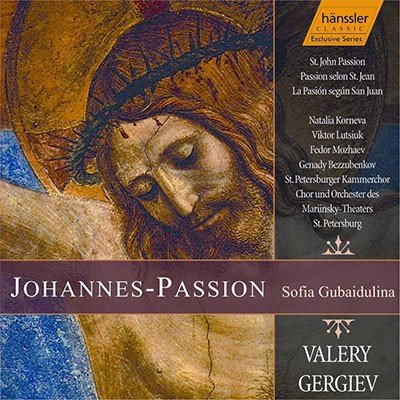St. John Passion
(Johannes-Passion) (2000)Sofia Gubaidulina (from liturgical sources) (R)
4(III,IV=picc).1.4(III=Ebcl,IV=bcl).1-3(I-III=Wagner.tubas).3(III=btpt).3.1-perc(6):timp/crot/bar.chimes/SD/3BD/cyms/susp.cym/5gongs/2wind.gongs/2tam-t/2 sets t-bells/bell.plate/glsp/vib/marimba-pft-synth-strings(16.14.12.10.8)
Tech Requirements
This work requires additional technological components and/or amplification, for more information please contact [email protected]
Abbreviations (PDF)
Sikorski
Sofia Gubaidulina's great oratorio based on texts by St John the Evangelist consists of the parts ‘St John Passion’ and ‘St John Easter’.
The composer initially wrote the 90-minute ‘St John Passion’ for the year 2000 to mark the 250th anniversary of Johann Sebastian Bach's birth, commissioned by the Bachakademie Stuttgart. The special music-historical significance of the work lies in the fact that this is the first ever Russian Passion setting. A contrast to the dark events of the Passion is provided by the Easter Oratorio after St John, which was commissioned by the Norddeutscher Rundfunk a year later and lasts just under an hour, thematising the idea of resurrection and redemption in lighter, more lyrical tones. This completes Gubaidulina's St John cycle, which she always refers to as her ‘opus summum’. The world premiere of the complete cycle took place on 16 March 2002 in Hamburg's St. Michael's Church under the direction of Valery Gergiev.
The theological trick that ultimately makes this Passion and Easter setting so unique, both in terms of content and music, is the juxtaposition of texts from the Gospel of John with passages selected by the composer from the Secret Revelation of John.
This interpolation of the heavenly vision lends the Passion narrative a tremendous dimension of depth in the history of salvation. The redemptive event is thus already foreshadowed in Revelation and embedded in an eternal context. Gubaidulina interweaves both levels in such a way that the apocalyptic events in heaven seem like a reaction to the Passion of Jesus. The temporal events of the Gospel thus form a horizontal axis, while the heavenly revelation outside our earthly world forms a vertical axis. In this way, Sofia Gubaidulina connects the earth with heaven in an extremely striking way, which for the composer is symbolically expressed in the form of the cross.
From the very beginning, Gubaidulina planned to end her ‘St John Passion’ with the resurrection of Jesus and St John's vision of a new heaven and a new earth. However, as the Passion composition took on ever greater proportions, she decided to dedicate a separate Easter oratorio to the resurrection theme, which she believed should be performed after the Passion. This is because, according to her conviction, it is only in the resurrection that man's redemption from his guilt takes place, with which the Passion composition ends. Thus, for Gubaidulina, ‘St John's Easter’ is the necessary completion of the Passion in terms of salvation history. (Hans-Ulrich Duffek)

Genady Bezzubenkov/Fedor Mozhaev/Viktor Lutsiuk/
St Petersburg Chamber Choir/
Mariinsky Theatre Chorus and Orchestra/
Valery Gergiev
Hänssler Classic CD 98405 (2 CD)

